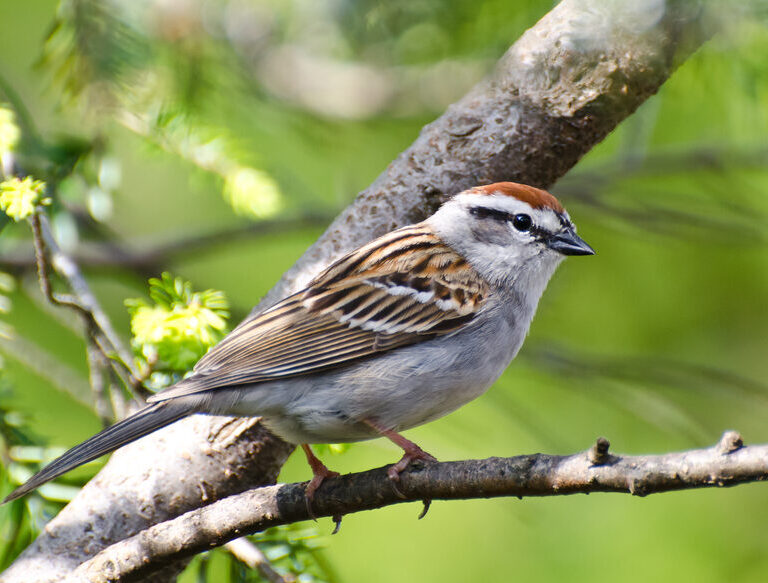Chipping Sparrow, Spizella passerina
Bill Rowe
The Chipping Sparrow, just about the epitome of a “cute little bird,” is one of those standard, widespread species that we all need to be familiar with, as we are sure to find them at some season wherever we go in North America—the only exceptions being northernmost Canada, much of Alaska, and southernmost Florida, as you can see from the map in the link below. In fact, we’ll find them as breeding birds over the better part of that whole continental range, from the woods and parks and towns of the East to the ponderosa pines of the Rockies and the live oaks of California. In all of these more or less wooded situations, their simple trilling song is one of the common background sounds of summertime. Come fall, they vacate the more northern areas, migrating in flocks and thereby giving us a better chance to study a whole lot of Chipping Sparrows—which helps with our identification skills, because fall and winter are the times when this bird is a bit less distinctive. In winter they are concentrated in northern Mexico and the southeastern U.S., up to the “mid-south” states like Arkansas and Tennessee; beyond that latitude, they have been considered rare but now are gradually inching northward as winter visitors or residents.
IDENTIFICATION: Adult Chipping Sparrows in spring and summer are easy: see the banner photo above. They are plain light gray underneath (no streaks), with a rusty-red cap that contrasts with a bold white eyebrow (or “supercilium” in birder jargon) and a black line through the eye. Fall and winter birds have a streaky brown cap that is reddish in adults, plain brown in immature birds. They also show a duller buff-colored eyebrow, a brown cheek patch, and that same prominent black line that goes through the eye and continues to the bill (see photo below, left). This face pattern is the key to recognizing Chipping Sparrows in fall migration and in winter. The main confusion species is the closely related Clay-colored Sparrow, which also has a streaky crown and a brown cheek—but it’s rare in eastern Missouri. Check your field guide for the face-pattern differences, and, if in doubt, try to see the rump (lower back); it is contrastingly gray in a Chipping but tan or brown like the back in a Clay-colored. One final tricky point is that young Chipping Sparrows in fall may retain the streaked underparts of their juvenile plumage, which is not shown in some field guides (see photo below, right).
ST. LOUIS STATUS: A fairly common breeding bird in parks, open oak woods, and other areas with well-spaced trees including some residential neighborhoods. In spring and fall migration, can appear anywhere. And in winter, still unusual but less rare than formerly; might show up at your feeder.
Learn more and listen to the songs and calls of Chipping Sparrows here.


Nonbreeding plumage,
fall and winter
Photo Credit: Al Smith
Fall, retaining some
juvenile plumage




